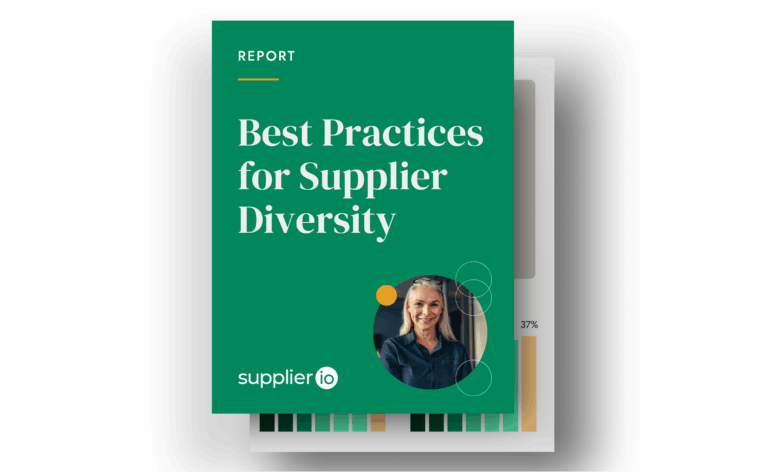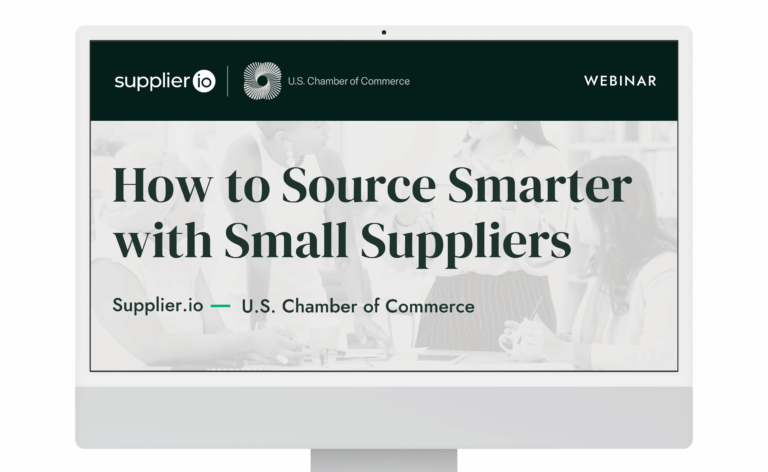Different Supplier Diversity Program Goals
Supplier diversity brings high ideals to the business world and the overall economy. Opportunity, inclusion, community, success—these are common goals for supplier diversity professionals.

Supplier diversity brings high ideals to the business world and the overall economy. Opportunity, inclusion, community, success—these are common goals for supplier diversity professionals and the suppliers they find, hire, and develop. Yet the two sides aren’t as united in achieving these goals as perhaps they should be.
Every year Supplier.io publishes an annual State of Supplier Diversity report. We surveyed hundreds of supplier diversity professionals and diverse suppliers, who again offered incredible insight on the industry. What we found particularly intriguing were the answers to open-ended questions we asked—and this is where we discovered a possible disconnect between the diversity programs and the suppliers they contract.
Therefore, the data and the responses from our reports lead to another question: Do all supplier diversity professionals share the same goals? To approach an answer to this question and determine if there is a gap among professionals and between programs and suppliers, let’s delve deeper into the survey results.
Noble Goals
A prominent question on our supplier diversity professionals report was this:
What are the primary drivers of your supplier diversity program?
Respondents could select more than one answer—as many as applied to their programs. The top choice was alignment with corporate culture, with 81 percent of respondents citing it as a primary driver. Coming in close second was and corporate social responsibility 80%. These were the runaway top choices, with no other option drawing more than 50 percent. The results suggest supplier diversity professionals value the importance of their efforts and believe in the power of diversity to deliver opportunities and strengthen communities.
Don’t Forget Business Objectives
Supplier diversity programs are extensions of the businesses they serve, and as such, financial objectives remain important. Supplier diversity is proven to strengthen the bottom line, thanks to a stronger supply chain and government incentives, among other reasons. So, the fact that the next top primary drivers cited in our survey were supply chain competitiveness (63%), enhanced brand (48%) and customer requirements (56 percent), should be no surprise. The grand ideals are there, but the business goals are never far behind.
What Supplier Diversity Professionals Are Saying
From the comments we received in our reports, supplier diversity professionals generally are proud of what they do and the opportunities they help provide. They recognize the challenges of finding diverse suppliers and gaining executive support, but they also cherish making a difference. When asked what they enjoy about supplier diversity, some of the responses these professionals gave included:
- “Being a part of something meaningful that positively impacts our brand and sales.”
- “Being able to support the community and growing economy.”
- “Advocating for equity, diversity, and inclusion and seeing the reality of real-time/real-life contracts for all. Making inroads for small-business concerns beyond supplier diversity to a competitive culture of equality for all businesses.”
- “It is a terrific way to earn new business.”
- “Meeting and connecting with those who are willing to do more than just dream but seek and find alignment with those with similar goals to make a difference in the economy, community, and individual lives.”
- “The passion I have, and also being in a position to help suppliers grow and create new jobs that impact the communities we serve.”
- “Seeing small, minority-, women-, and disadvantaged-owned businesses land opportunities and create jobs for their community.”
- “The knowledge that comes from a diverse set of viewpoints.”
What Diverse Suppliers Are Saying
A number of suppliers also participated in our survey said they aren’t finding the opportunities supposedly out there. And this is vexing for suppliers, to say the least. When asked what challenges they experienced, the diverse supplier respondents’ mood was markedly different than that of the supplier diversity professionals:
- “A lot of companies support supplier diversity, but it’s more of if the diverse supplier is less expensive than a non-diverse supplier. The initiative is there in name …”
- “Being given a chance to show performance capability when my business has yet to secure an opportunity. How do we gain experience if an opportunity is not presented?”
- “Too often, supplier diversity people are not integrated into procurement and/or do not have the authority to connect our company with the decision makers who can use our services.”
- “Constantly being excluded from business opportunities because we are an LGBTQ.”
- “Corporations don’t seem to want to provide the hand up that’s needed. Consistently trying to prove our value.”
- “Generally, the supplier diversity offices can provide direction but often do not have the capability to influence decisions that help us to compete. They seem to be more gatekeepers than anything else. We seek to have the opportunity to compete and often aren’t given the same opportunity as some others.”
- “I feel like companies advertise and market that they support supplier diversity, but in reality, they do not. It is very frustrating when they say they do and won’t even take our phone call.”
- “Being taken seriously and only being seen as extra spend, not budget spend.”
Bridging the Gap
Suppliers’ frustration is real, as they feel supplier diversity programs put the bottom line ahead of stated goals and philosophies. Supplier diversity professionals believe in their cause but still must ensure their efforts are helping the company, not hurting it. This is the gap that became evident in our, but the divide isn’t so wide that it can’t be bridged.
For supplier diversity programs, communication is key. Obviously, the better relationships professionals can build with suppliers, the easier it will be for those professionals to determine if a supplier will be a good fit for their company (as well as identify prime candidates for supplier development). Moreover, communicating with other departments and executives is critical. We saw survey responses from supplier diversity professionals and suppliers that executive buy-in or even awareness often wasn’t there, and as a result, success was hampered or denied.
Also, if building a rapport with suppliers is so important for supplier diversity professionals, then you need to find the time to do so. This is where great supplier diversity software helps. Instead of chasing down the particulars of a diverse supplier or spending hours sorting through spend data, the best solutions do the work for you, thus freeing up resources so you can form partnerships and bridge gaps.
For diverse suppliers, earning certifications and being active in the supplier diversity community (e.g., attending events or participating in industry groups and discussions) are perhaps the best strategies to find companies to work with and vice versa. Certification processes require some advanced effort, and being certified doesn’t always guarantee supplier diversity programs will be knocking down your door, but formal certification remains almost mandatory in today’s supplier diversity space (especially because 53 percent of programs won’t consider self-certified suppliers).
Some supplier diversity programs are outstanding at what they do, and some can improve. The same applies to diverse suppliers—some deliver excellent goods and services, and others are simply not good fits for the companies considering them. Nevertheless, the two sides share many similar goals, and that mutual passion ultimately can bridge the gap and strengthen supplier diversity.




